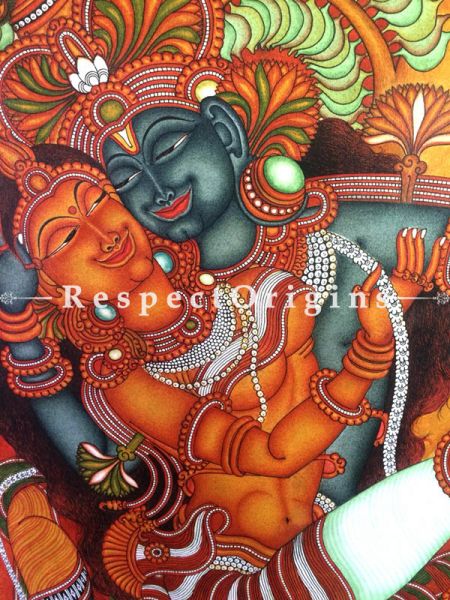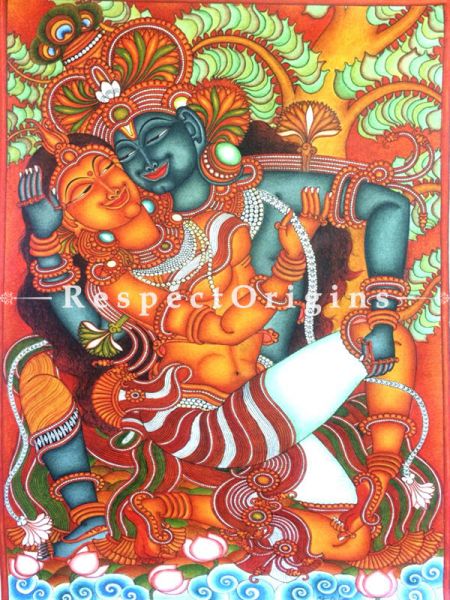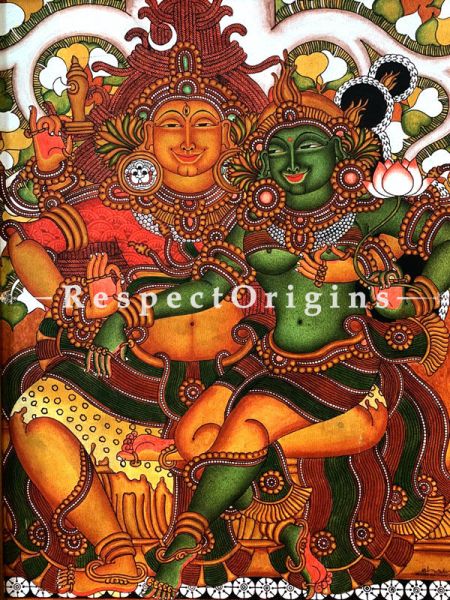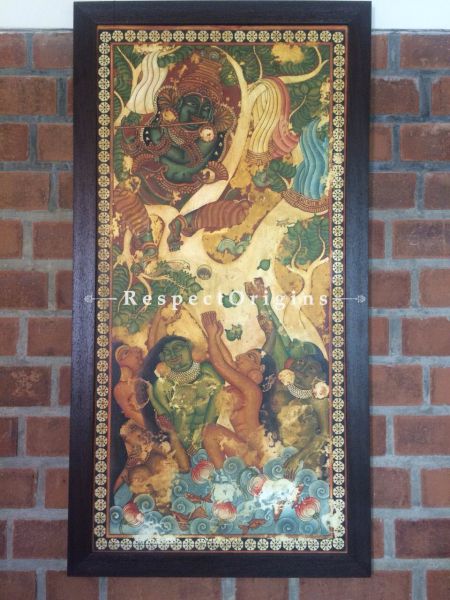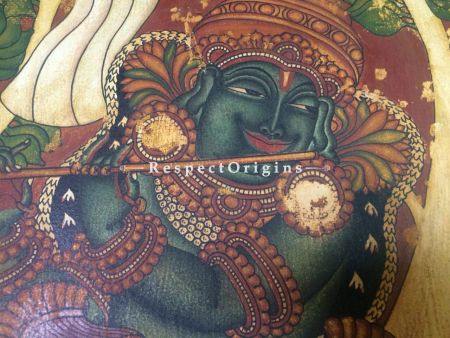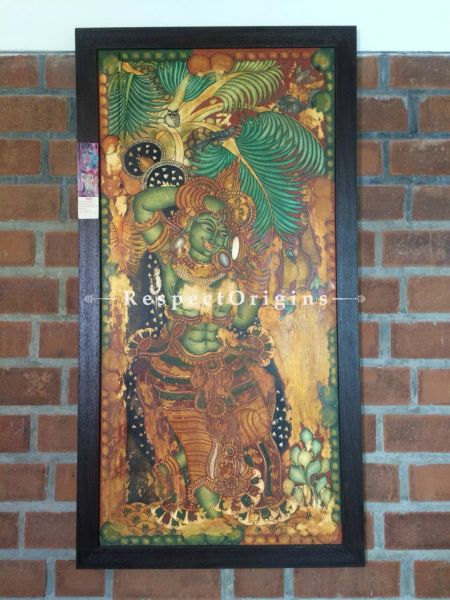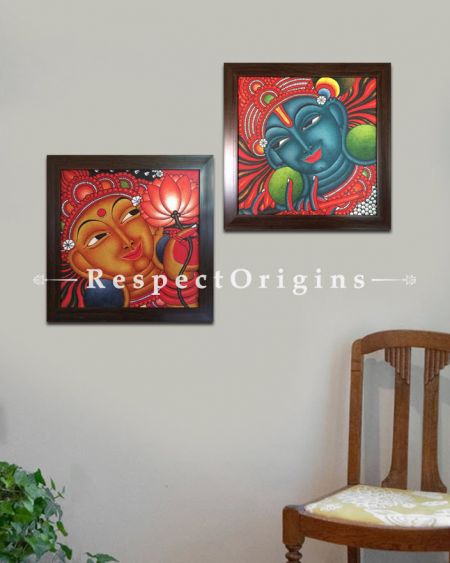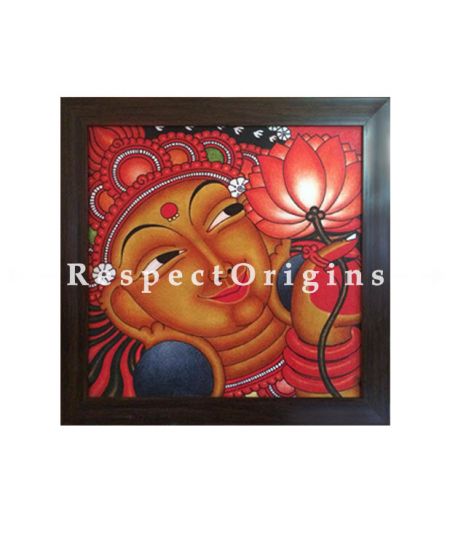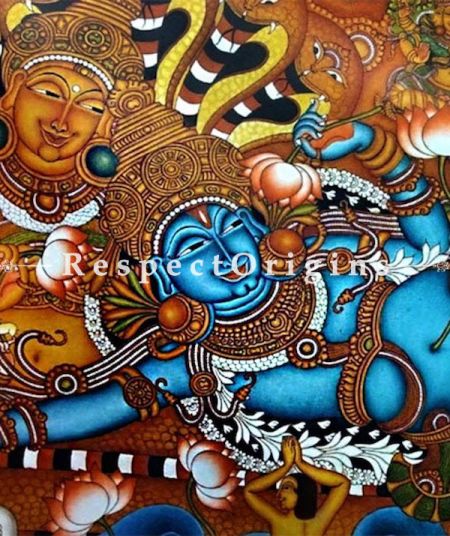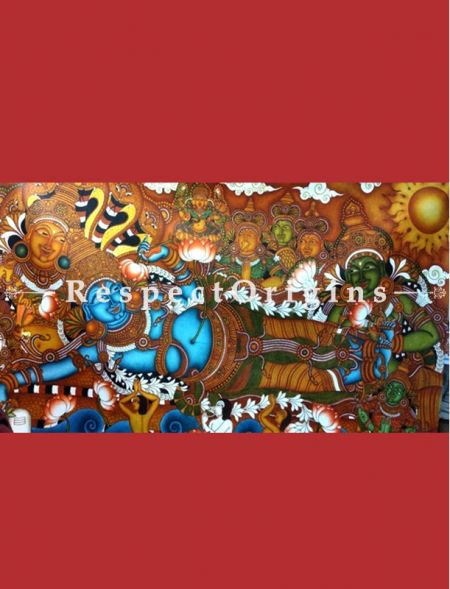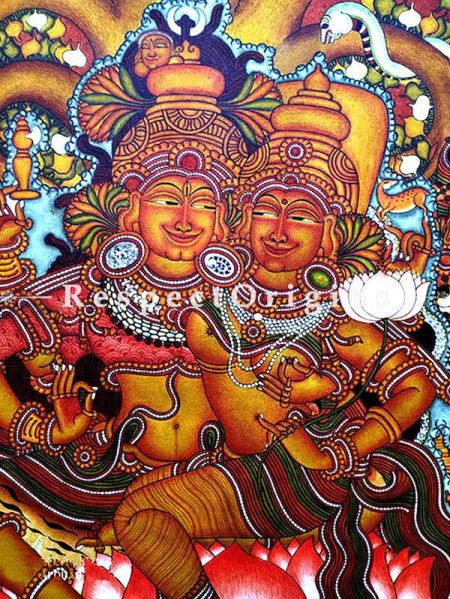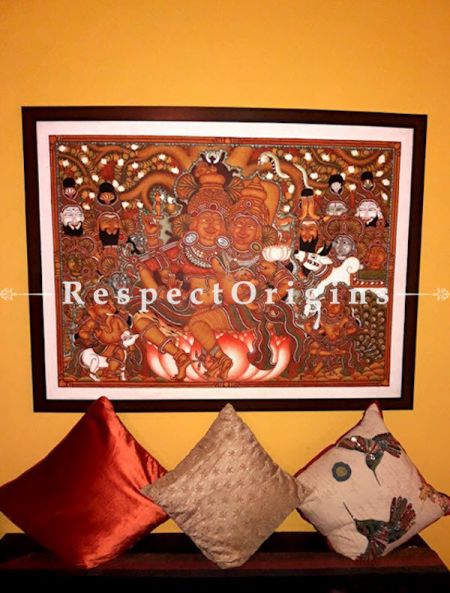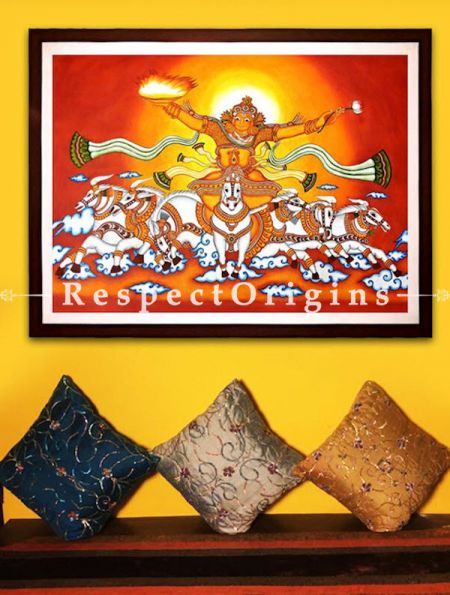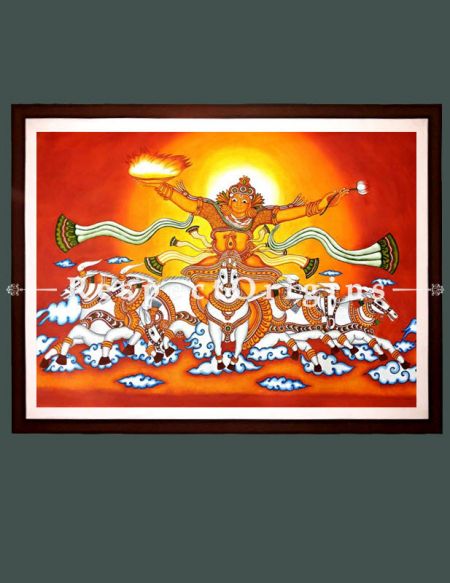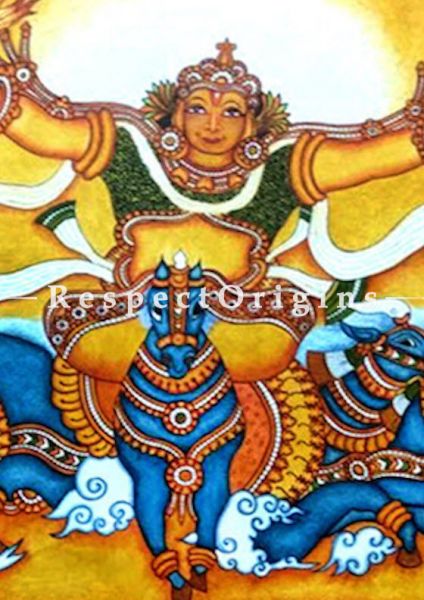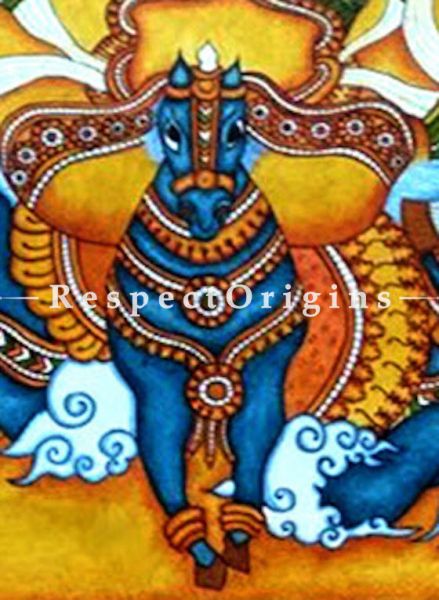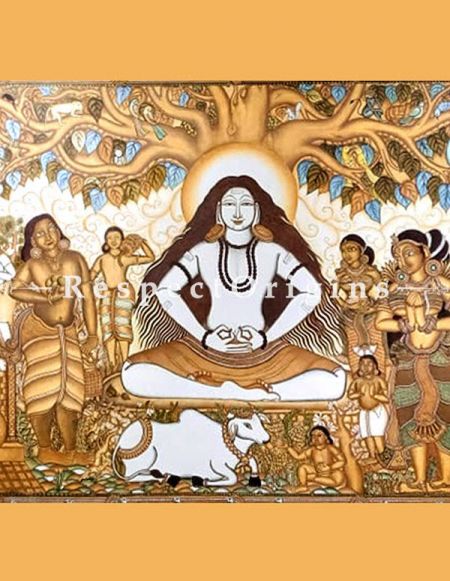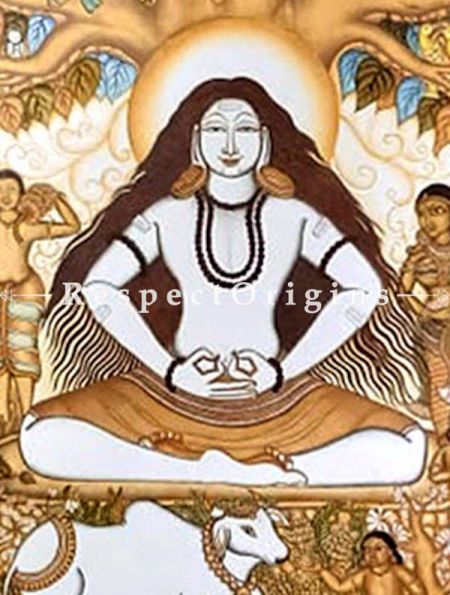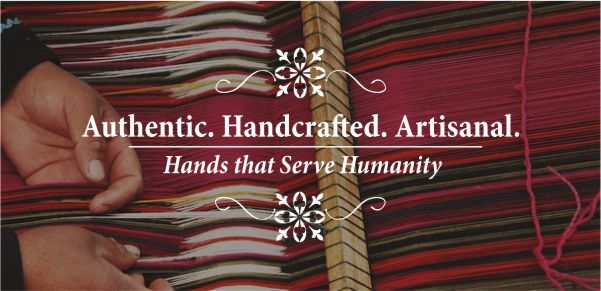Mural
- Radha Krishna Chuvarcharitram; Kerala Mural Painting; 35x23 Inches$471.00This Kerala Mural Depicts Lord Krishna and Radha. together Radha and Krishna Are Believed to Be The Combined forms of Masculine and Feminine Realities of God. Kerala Mural Paintings Are Frescos Showcases Legends and Hindi Mythology Which Are Drawn On The Walls of Churches and Temples In Southern India, Principally In Kerala. These Type of Paintings Date Back to 9Th - 12Th Century Ce When This form of Art Enjoyed Royal Patronage. This Traditional Wall Mural from Kerala Is Heavenly. The Colors Traditionally Used Are Green for Satvic, Red and A Mixture of Red and Yellows for The Rajasic and Black (Shivite) and White (Vaishanavite) for The Tamasic Deities. The Most Predominant Colour Used In Kerala Murals Is Saffron-Red. It Is A Vertical Painting 35x23 Inches. It is without frame.
- Kerala Mural Painting of Shiv Parvati; 25x20 Inches$314.00This Following Mural Painting Depicts Shiva Parvati. Shiv Is Also Known As Mahadeva (The Great God) and Is Known to Be One of The Principal God In Hinduism. He Is Also Titled As "The Destroyer". Parvati Is The Hindu Goddess of Love, Fertility, Beauty and Devotion. She Is The Mother Goddess In Hinduism. This Traditional Wall Mural from Kerala Is Heavenly. The Colors Traditionally Used Are Green for Satvic, Red and A Mixture of Red and Yellows for The Rajasic and Black (Shivite) and White (Vaishanavite) for The Tamasic Deities. The Most Predominant Colour Used In Kerala Murals Is Saffron-Red. Vegetable Dyes, Fruit Juices, Minerals and Natural Material Are Used for Making The Paint While Brushes Are Made from The Blades of Certain Type of Grass and Roots of Trees and Sharpened Bamboo Pieces Are Used to Draw The Outline. It Is A Vertical Mural Painting In 25x20 Inches. It is without frame.
- Vastraharan; Kerala Mural Painting; 43x22 Inches$704.00This Masterpiece Mural Paintings Depicts The Activity of Vastraharan. The Boy Krishna Would often Steal The Clothes of The Gopis When They Went to Bathe In The Waters. He Would Always Tease Them With Other Activities like Stealing Their Home Made Butter Etc. It Would Project A Child's Innocence, Purity and Naughtiness. This Traditional Wall Mural from Kerala Is Heavenly. The Colors Traditionally Used Are Green for Satvic, Red and A Mixture of Red and Yellows for The Rajasic and Black (Shivite) and White (Vaishanavite) for The Tamasic Deities. The Most Predominant Colour Used In Kerala Murals Is Saffron-Red. Vegetable Dyes, Fruit Juices, Minerals and Natural Material Are Used for Making The Paint While Brushes Are Made from The Blades of Certain Type of Grass and Roots of Trees and Sharpened Bamboo Pieces Are Used to Draw The Outline. It Is A Vertical Mural Painting of Vastraharan 43x22Inches. It is without frame.
- Kerala Mural Painting of Sundara Yakshini; 43x23 Inches$704.00This Particular Mural Painting Depicts A Sundara Yakshini. Yakshinis Are Mythical Beings(Equivalent to That of An Angel Or Apsara) of Buddhist, Jain and Hindu Mythology. They Are Attendees of Kubera, The God of Wealth Who Resides In Mythical Himalayan Kingdom of Alaka.This Traditional Wall Mural from Kerala Is Heavenly. The Colors Traditionally Used Are Green for Satvic, Red and A Mixture of Red and Yellows for The Rajasic and Black (Shivite) and White (Vaishanavite) for The Tamasic Deities. The Most Predominant Colour Used In Kerala Murals Is Saffron-Red. Vegetable Dyes, Fruit Juices, Minerals and Natural Material Are Used for Making The Paint While Brushes Are Made from The Blades of Certain Type of Grass and Roots of Trees and Sharpened Bamboo Pieces Are Used to Draw The Outline. It Is A Vertical Mural Painting 43x23 Inches. It is without frame.
- Square Kerala Mural Painting of Lord Krishna and Radha; 18x18 Inches$579.00This Kerala Mural Depicts Lord Krishna and Radha. Kerala Mural Paintings Are Frescos Showcases Legends and Hindu Mythology Which Are Drawn On The Walls of Churches and Temples In Southern India, Principally In Kerala. These Type of Paintings Date Back to 9Th - 12Th Century Ce When This form of Art Enjoyed Royal Patronage. This Traditional Wall Mural from Kerala Is Heavenly. The Colors Traditionally Used Are Green for Satvic, Red and A Mixture of Red and Yellows for The Rajasic and Black (Shivite) and White (Vaishanavite) for The Tamasic Deities. The Most Predominant Colour Used In Kerala Murals Is Saffron-Red. Vegetable Dyes, Fruit Juices, Minerals and Natural Material Are Used for Making The Paint While Brushes Are Made from The Blades of Certain Type of Grass and Roots of Trees and Sharpened Bamboo Pieces Are Used to Draw The Outline. It Is A Square Painting 18x18 Inches. It is without frame.
- Reclining Vishnu Kerala Mural Art or Painting Large on canvas; 36x58 in; Chuvarchithram$2,198.00This Show-stealer, Large Rectangular Reclining Vishnu Kerala Wall Mural This Kerala traditional wall mural is made using a technique where thousands of tiny dots are used in varied density to shade define and highlight the contours, tones, moods and grandeur of deities. The art was originally a celebration of Hindu Deities but now includes all faiths and holy iconic figures and scenes. in this painting Vishnu, The Preserver, in the Hindu Trinity of deities is glorious in his characteristic marine blue. Poised gracefully upon the naga. Notably even though all the colours are bright and Striking, the contrasts have been balanced so well that an aura of joy prevails. One can almost smell the fragrance of the white flowers... white or Shweta varna, in Sanskrit is the colour of purity. He is attended to by Devi devtas whole he rests and symbolize the preservation of good over evil and harmony over disruption. All the paints are sourced from local, natural products only. No synthetic or chemical products are used nor treatments done. It is without frame.
- Shakthipanjakshari Shiva; Shiva Family Large Kerala Mural Art On Canvas; 45x32 in$1,605.00Shiva Is One of The Principal Deities of Hinduism And Is Known As The "Creator, Maintainer And The Destroyer" Within The Trimurti, The Hindu Trinity That includes Brahma And Vishnu. He Is Also Depicted As A Yogi Who Lives An Ascetic Life On Mount Kailash With Wife Parvati And His Two Children, Ganesha And Kartikeya And Is Regarded As The Patron God of Yoga, Meditation And Arts. This Traditional Wall Mural From Kerala Stands Out For Its Irresistible Clarity. The Colors Traditionally Used Are Green For Satvic, Red And A Mixture of Red And Yellows For The Rajasic And Black (Shivite) And White (Vaishanavite) For The Tamasic Deities. The Most Predominant Colour Used in Kerala Murals Is Saffron-Red. Vegetable Dyes, Fruit Juices, Minerals And Natural Material Are Used For Making The Paint While Brushes Are Made From The Blades of Certain Type of Grass And Roots of Trees And Sharpened Bamboo Pieces Are Used To Draw The Outline. It is without frame.
- Lord Surya- Sun God- Painting Kerala Mural Art 42x60; Horizontal Canvas painting$658.00Surya Known As Aditya Is The Hindu God of The Sun And Is The Son of Kashyapa Muni And Aditi And Is The Source of All Life And He Travels Every Day in The Sky in His Golden Chariot Pulled By Seven Horses And Driven By Red Aruna, A Personification of Dawn. He Had Had Three offspring With Samjna (Conscience), The Daughter of Visvakarma. These Were Vaivasvata (One of The 14 original Men or Manu), Yama (God of The Dead), And Yami (Goddess of The Yamuna River). Lord Surya Is The Main God in Navagraha All The Other Navagraha Like Moon, Mercury, Mars, Venus, Jupiter, And Saturn, Plus The Solar And Lunar Shadows (Ascending And Descending Nodes) of Rahu And Ketu, All Visible To The Naked Eye Revolves Around Him. Surya Is Considered The Chief of The Nine Planets of Vedas. These Are The Sun, Collectively They Are Known As The Navagraha. . Lord Surya Had Many Temples And Shrines Across Ancient India But Certainly The Most Celebrated Temple Built in Honour of Surya Is in The Orissa Region At Konarak. Another Famous Temple Dedicated To The God Is At Martand in The Srinagar Valley of Kashmir Which Was Built in The Second Half of The 8Th Century Ce By The Karkota King Lalitaditya. This Traditional Wall Mural From Kerala Stands Out For Its Artistic Brilliance . The Colors Traditionally Used Are Green For Satvic, Red And A Mixture of Red And Yellows For The Rajasic And Black (Shivite) And White (Vaishanavite) For The Tamasic Deities. The Most Predominant Colour Used in Kerala Murals Is Saffron-Red. Vegetable Dyes, Fruit Juices, Minerals And Natural Material Are Used For Making The Paint While Brushes Are Made From The Blades of Certain Type of Grass And Roots of Trees And Sharpened Bamboo Pieces Are Used To Draw The Outline. It is without frame.
- Lord Surya- Sun God- Painting-Kerala Mural Art 42x60 in Canvas Horizontal$658.00Surya Known As Aditya Is The Hindu God of The Sun And Is The Son of Kashyapa Muni And Aditi And Is The Source of All Life And He Travels Every Day in The Sky in His Golden Chariot Pulled By Seven Horses And Driven By Red Aruna, A Personification of Dawn. He Had Had Three offspring With Samjna (Conscience), The Daughter of Visvakarma. These Were Vaivasvata (One of The 14 original Men or Manu), Yama (God of The Dead), And Yami (Goddess of The Yamuna River). Lord Surya Is The Main God in Navagraha All The Other Navagraha Like Moon, Mercury, Mars, Venus, Jupiter, And Saturn, Plus The Solar And Lunar Shadows (Ascending And Descending Nodes) of Rahu And Ketu, All Visible To The Naked Eye Revolves Around Him. Surya Is Considered The Chief of The Nine Planets of Vedas. These Are The Sun, Collectively They Are Known As The Navagraha. . Lord Surya Had Many Temples And Shrines Across Ancient India But Certainly The Most Celebrated Temple Built in Honour of Surya Is in The Orissa Region At Konarak. Another Famous Temple Dedicated To The God Is At Martand in The Srinagar Valley of Kashmir Which Was Built in The Second Half of The 8Th Century Ce By The Karkota King Lalitaditya. This Traditional Wall Mural From Kerala Stands Out For Its Artistic Brilliance . The Colors Traditionally Used Are Green For Satvic, Red And A Mixture of Red And Yellows For The Rajasic And Black (Shivite) And White (Vaishanavite) For The Tamasic Deities. The Most Predominant Colour Used in Kerala Murals Is Saffron-Red. Vegetable Dyes, Fruit Juices, Minerals And Natural Material Are Used For Making The Paint While Brushes Are Made From The Blades of Certain Type of Grass And Roots of Trees And Sharpened Bamboo Pieces Are Used To Draw The Outline. It is without frame.
- Lord Pashupatinath- Shiva- Painting Kerala Mural Art72x96; Canvas Vertical Painting$1,975.00Pashupati Also Known As The Lord of Animals Is An incarnation of Lord. in Shaivism, Humans Are Considered Animals Until They Achieve Liberation. Shiva Is The Husband Called Pati in Hindis or The Lord of All Creation. Hence, He Is Called Pashupati And Is Lord of The Animal Nature in Us, Which Is A Direct Consequence of Tamas, One of The Triple Gunas, Which He Personifies. He Rides The Sacred Bull Nandi, Which Is His Vehicle And Personifies The Animal (Pasu or Pashu) or The Animal Nature (Especially Lust or Virility), And He Rides Upon It As Its Lord. He Is Revered Throughout The Hindu World, But Especially in Nepal, Where He Is Commonly Known As Pashupatinath Is An Avatar of Shiva, One of The Hindu Trinity .The Five Faces of Pashupatinath Represent Different incarnations of Shiva; Sadyojata Known As Barun, Vamdeva Known As Uma Maheswara, Tatpurusha, Aghor & Ishana. They Face West, North, East, South And Zenith Respectively, And Represent Hinduism's Five Primary Elements Namely Earth, Water, Air, Fire And Space. This Traditional Wall Mural From Kerala Stands Out For Its Artistic Brilliance . The Colors Traditionally Used Are Green For Satvic, Red And A Mixture of Red And Yellows For The Rajasic And Black (Shivite) And White (Vaishanavite) For The Tamasic Deities. The Most Predominant Colour Used in Kerala Murals Is Saffron-Red. Vegetable Dyes, Fruit Juices, Minerals And Natural Material Are Used For Making The Paint While Brushes Are Made From The Blades of Certain Type of Grass And Roots of Trees And Sharpened Bamboo Pieces Are Used To Draw The Outline.. It is without frame.


